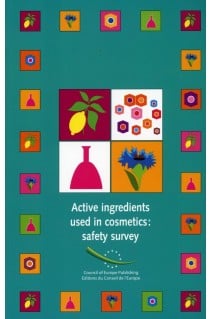



Ingredients are used in cosmetics to give them specific properties. Certain ingredients, so called active ingredients, may produce pharmacological or toxic effects under certain conditions. Cosmetic products containing such ingredients may pose a health risk both because of their potential toxicity and because they may mask underlying serious diseases and consequently cause a dangerous delay in diagnosis and treatment.The objective of this study is to give safety information on certain active ingredients which give raise to toxicological concerns and for which restrictions of use in cosmetics should be considered.Monographs were prepared for 45 active ingredients for which no specific regulations exist including, inter alia, information about uses, properties, a risk evaluation of the use in cosmetic products considering as toxicological endpoints both systemic and local effects. Each monograph includes a bibliography, conclusions and recommendations.The study complements a series of three volumes containing monographs about the safety of certain natural ingredients used in cosmetics and will serve as a useful reference in the field, for health authorities, manufacturers and health professionals in particular.
General background
1. Aim of the safety survey
2. General principles, procedures and criteria
2.1 Selection of ingredients
2.2 Working methods
2.3 Type of data collected and criteria
2.4 Outlook
45 Safety monographs on specific active ingredients
1. Aloe extracts with anthraquinones
2. Aminophylline
3. Arbutin
4. Arnica montana extracts of flower heads
5. Azelaicacid
6. Balsam of Tolu
7. Caffeine
8. Camphor
9. Chelidonium majus extract
10. Domiphen bromide
11. Econazole
12. Elubiol
13. Glycyrrhetinic acid
14. Escin
15. Esculin
16. Eucalyptol
17. Foeniculum vulgareessential oil
18. Fucusvesiculosus
19. Fumaricacid
20. Ibuprofen
21. Iodine organically bound
22. Ketoconazole
23. Kojicacid
24. Melatonin
25. Menthol
26. Methyl nicotinate
27. Methyl salicylate
28. Miconazole
29. Sodium perborate
30. Persulfatesalts
31. Podophyllum peltatum extract
32. Pregnenolone/ Pregnenolone acetate
33. Retinaldehyde
34. Retinol
35. Rutin
36. Sassafras albidum essential oil
37. Stevioside
38. Symphytum offidnale extracts
39. Theophylline
40.Tioxolone
41. Tocopherol/Tocopherol esters
42. Tranexamic acid
43. Tussilago farfara
44. Urea
45. Usnic acid/Usnic acid salts
Appendix 1 -List of abbreviations
Appendix 2-List of authors
Appendix 3 - Members of the Committee of Experts on Cosmetic Products
Index
Télécharger un extrait (1000)

Ingredients are used in cosmetics to give them specific properties. Certain ingredients, so called active ingredients, may produce pharmacological or toxic effects under certain conditions. Cosmetic products containing such ingredients may pose a health risk both because of their potential toxicity and because they may mask underlying serious diseases and consequently cause a dangerous delay in diagnosis and treatment.The objective of this study is to give safety information on certain active ingredients which give raise to toxicological concerns and for which restrictions of use in cosmetics should be considered.Monographs were prepared for 45 active ingredients for which no specific regulations exist including, inter alia, information about uses, properties, a risk evaluation of the use in cosmetic products considering as toxicological endpoints both systemic and local effects. Each monograph includes a bibliography, conclusions and recommendations.The study complements a series of three volumes containing monographs about the safety of certain natural ingredients used in cosmetics and will serve as a useful reference in the field, for health authorities, manufacturers and health professionals in particular.
Attention, en vertu de nos conditions générales de vente, l'achat des PDF/epub est réservé aux particuliers.
